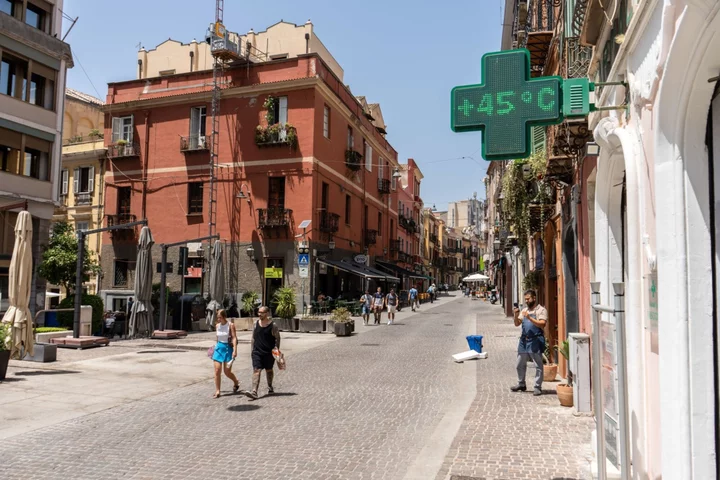Emily Wilkie’s introduction to motherhood has been monopolized by heat.
A 34-year-old charity director, Wilkie lives in London with her husband and their four-month-old son Dylan. Their apartment’s large windows make for an airy space that appealed to Wilkie’s husband when he bought the place, but they also let in constant sunlight. Once the temperature outside cracks 27C (80F), the flat stays at least three degrees warmer. In summer months, the family dog wears a cooling vest. Dylan, Wilkie says, is “constantly sweaty.”
“It just makes him so miserable,” she says. “You have all this guilt about being a bad mum. It is really stressful.”
Dylan’s doctor advised keeping his room between 18C and 20C, an impossible ask in the family’s un-air-conditioned home, even on temperate nights. On hot days, Wilkie tries to spend as much time in AC as possible: long trips to the grocery store, or hours spent in the library. If temperatures cross 30C, she and Dylan plan to abscond to Wilkie’s parents house in Sheffield. It doesn’t have air-conditioning either, but there’s more space and lower temperatures up north.
Wilkie’s family is one of millions struggling in hot homes across the UK and Europe, the world’s fastest-warming continent due to climate change. Heat waves in the region are becoming more frequent and intense, creating livability issues in cities that have long gotten by without air-conditioning, where both old and new homes aren’t built for high heat. Many people in inadequately cool housing are struggling to sleep, work and relax, and some have little recourse — only the promise of hotter days ahead.
How hot it should be indoors is a threshold that varies across the UK and Europe.
France has a mandatory maximum of 26C in sleeping rooms at night. Ireland caps bedrooms at 26C and living rooms at 28C. Spain gets more granular, setting maximums for different rooms and requiring buildings to use shading at a certain level of solar gain (the amount of heat a building absorbs from the sun). Some countries set static temperature limits, while others vary them by region or, in England’s case, based on weather conditions outside.
For all of those guidelines, though, one recent academic survey concluded that few European countries have building codes sophisticated enough to shield residents from overheating. Researchers cited issues such as not distinguishing between living rooms and sleeping rooms, ignoring the urban heat island effect (which makes cities hotter than surrounding areas) and not taking into account the effects of climate change.
Residents of overheating homes don’t always know who to appeal to, if anyone. Homeowners are generally stuck with what they paid for, and the adjustments they can make themselves. Renters can try taking a landlord to court, but only after sorting through murky and inconsistent guidelines on what makes for unlivable indoor conditions. Developers, meanwhile, are rarely required to do more than say they’re compliant with local temperature regulations.
“In most standards, if not all, there is no inspection and verification either after design or after construction,” says Shady Attia, professor of sustainable architecture and building technology at the University of Liège in Belgium, and lead author of the academic survey. “The situation is really bad for household owners and tenants in the coming years.”
When Ruth Ferris, 43, asked the owner of her five-story London apartment building whether she could install central air-conditioning, she got a hard no. So Ferris purchased three portable ACs. On the city’s hottest days, even they can’t keep up.
“It’s like a greenhouse,” says Ferris, who works for an investment bank and lives on the building’s top floor. “Half of my flat is essentially glass walls.”
As temperatures soar, sunlight pours in, and the whole building’s heat rises into Ferris’ flat. In the summer, her apartment regularly exceeds 30C; since buying it in 2017, Ferris has seen temperatures as high as 45C. At that point, “You can’t sleep. You don’t want to do anything,” she says. “A lot of the time I don’t want to go home.”
Max Hundhammer, 26, is also struggling to stay cool. He’s currently training to be a lawyer in Frankfurt, but getting any work done in the rented flat he shares with two roommates is difficult when summer temperatures routinely hit 30C.
“My room faces southeast, so I get a lot of sunlight and warmth in the early morning hours,” he says. “I can’t get this warmth out of my room during the day. If you sweat even when sitting at your desk, this does not necessarily facilitate daily tasks such as learning.”
Indoor overheating is typically affected by two things: how readily a building absorbs heat from external and internal sources, and how readily it dissipates heat through ventilation. Age, design and location play a role in both, says Giorgos Petrou, a researcher at University College London.
In 2019, a UK study co-authored by Petrou found that homes in urban areas, mid-terrace houses and purpose-built apartments (rather than conversions) had the biggest issues with overheating. Homes built after 1900 were more likely to overheat, as were those kept warm with communal or district heating. A separate study in the summer of 2018 found that 19% of UK bedrooms and 15% of living rooms overheated.
There are low-tech ways to adjust heat absorption and dissipation. Shutters, curtains, overhangs, greenery and other shadings reduce solar gain, as does limiting south- and southwest-facing glass. Being able to open doors or windows on two sides of a building dissipates heat through cross-ventilation.
Highly glazed homes built in the past 20 years, especially those with sealed floor-to-ceiling windows, are particularly vulnerable to heat, says Julie Godefroy, a sustainability consultant and head of net zero at the Chartered Institution of Building Services Engineers, an industry group. “It’s the worst of both worlds,” she says. “You get the solar gain, but you don’t get the airflow.”In the UK, regulations that took effect last year limit the amount of glazing on new buildings and mandate a certain surface area of openable windows and in some cases shading. They followed similar provisions in Portugal, which requires shading when windows are greater than 15% of the floor area of the room they’re in. Other countries, including Spain, limit the amount of solar heat a building is allowed to take in, indirectly limiting window expanse.
Older homes tend to have more suitable windows, but aren’t inherently cooler — especially if energy efficiency is poor. Most of the time, insulation is useful to guard against direct sun, Godefroy says: “You are actually protecting yourself from the heat outside.”
If housing in the UK and Europe is ill-equipped for current temperatures, this summer is a harbinger of challenges ahead. Temperatures have hit record levels across the continent, with severe heat waves in Italy, Spain and Greece. In the UK, record-breaking heat last summer, in which temperatures breached 40C, could be considered normal by 2060 and even cool by 2100, according to a study by the national weather service.
Europe’s aging population, more vulnerable to heat, is a growing risk factor. So is its housing stock. Air-conditioning penetration in the UK, France and Germany is estimated at under 5% of homes. Even in Italy, where hot weather is routine, AC shows up in less than a third of homes (though the last good data is a decade old). One report commissioned by the UK’s Climate Change Committee found that half of the country’s homes are currently at risk of overheating, at 1.2C of warming over the pre-industrial era. At 2C, it rises to 90%.
Alex Turney, 31, lives in Rome’s Testaccio district and spends her days as a freelance contributor to an app offering audio bedtime stories for adults. It’s ironic, then, that her sleep is suffering. This summer, temperatures have regularly exceeded 35C outside, leading to similar temperatures in the rented one-bedroom she shares with her dog Felix. The heat starts early; sleeping past 7 a.m. is a struggle, and Felix has to go for a walk before the pavement gets too hot for his paws.
The apartment wasn’t air-conditioned when Turney moved in — few in Rome are — so she bought a window unit for the living room, which doubles as her home office. Turney and Felix spend their days there, and nights in the bedroom with a fan and an ice pack on Turney’s feet.
“At 10 p.m. it’s still 30C outside, and my bedroom, because of the way it faces, gets a lot of sun in the afternoon,” she says. “It gets progressively hotter and it doesn’t cool down that much at night.”
Some 850 kilometers west, Àlex Sancliment, a 24-year-old student at the University of Barcelona, lives with his parents in the city’s suburbs. Their apartment’s living room has AC, as does his parents’ bedroom, but his does not. Daytime highs of 32C are becoming common in Barcelona, while temperatures in parts of Spain broke 45C this summer.
“Trying to study or sleep at home is really hard,” Sancliment says. The family’s next-door neighbor is in her 80s and has no air-conditioning in her apartment. During the summer months, she often takes a siesta in his parents’ bedroom.
Many Europeans, especially parents, are connoisseurs of cool spaces: They know where to go when it’s too hot at home. But even the best cool hunter can only do so much. Air-conditioned “cooling centers,” popular in places like the US — Phoenix has more than 40 of them — are virtually nonexistent in northern Europe. And no daytime AC oasis can help with night heat.
Across vast swaths of the globe, nights are warming at a faster rate than days. In many European countries, nights in which the temperature never falls below 20C are known as “tropical nights.” A succession of them limits the body’s ability to recover from daytime heat. Humans’ sleep cycle is key for regulating their internal temperature, and studies have found a link between heat-induced sleep disruptions and excess deaths, particularly from stroke.
“It’s the continuous pressure on the body,” says Maggie Rae, president of the UK Royal Society of Medicine’s epidemiology and public health section. “This is a very serious health hazard and one of the major concerns about climate change to human health.”
Scandinavia rarely struggles with nighttime heat — but it does have a sunlight challenge. In Sweden, the extra hours of summer daylight, generally considered a bonus, can become a liability when temperatures get too high.
“You’re never without the sun, which the Swedes would really berate me for complaining about,” says Hester Mott, 29, who is from the UK but lives in Stockholm. In a society that gets as little as six hours of daylight in winter, apartments with ample windows are in high demand. Mott, her partner and their newborn daughter live in one: a high-ceilinged rental that dates back to 1929.
The flat’s southwest-facing windows guarantee all-day sun but, because they’re all on one side, leave little ability to create a draft when it’s warm out. During summer months, temperatures in the flat can climb to 30C. Because of local restrictions on her building’s facade, Mott can’t install air-conditioning.
“We live in a typical Stockholm apartment building that’s built very much to withstand terribly cold winters,” says Mott, who works for a nonprofit. “We stay nice and toasty here during winter. But the downside is that it’s absolutely boiling in the summertime.”









